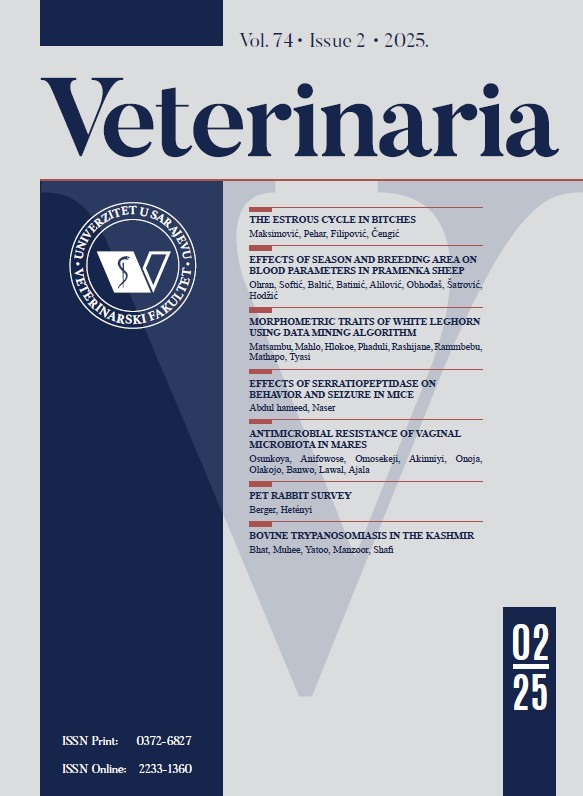Repair of left displaced abomasum in a cow with the TPS procedure using makeshift equipment
DOI:
https://doi.org/10.51607/22331360.2022.71.1.91Keywords:
Artificial insemination tube, fishing line, rumen trocar/cannula, toggle-pin sutureAbstract
Due to the need for veterinary intervention when surgery is required to correct a case of left displaced abomasum (LDA) in cattle, less expensive alternative procedures have been developed. The toggle-pin suture (TPS) procedure offers a lot of benefits, as it is a minimally invasive procedure with a high success rate. The purpose of this report is to show that it is possible to perform the TPS procedure with an available and low-cost material. It is about a case of recurrent indigestion that had lasted about 15 days in a 7-year aged Holstein dairy cow. Examination of the digestive system revealed overload of rumen and decreased motility, but the most significant clinical finding was an area of tympanic hyper-resonant “ping” heard on the left side of the flank, mainly in the middle and dorsal aspect of the abdomen at the level of the 9th to 12th intercostal space, revealed by auscultation and percussion exam. The decision was made to proceed with TPS for the abomasum repair because of the poor body condition of the cow, which may not survive surgery. Then, we proceeded with a supportive treatment in order to prepare the cow for the abomasum repair, scheduled
for the next day. The cow received an infusion of NaCl 0.9% and glucose 5%, and a general tonic injected via IM route. The improvised equipment consisted of: a medium trocar/cannula with a diameter of 10 mm to be used for rumen puncture, a 15 cm push rod, 5 cm rods made using a tube for bovine artificial insemination (5 mm diameter), and a lined fishing line (USP n°1) used to tie the rods. Iodine tincture 10% was used for disinfection of the equipment and for puncture site antisepsis. The cow was cast on her right side and rolled onto her back, and her front and rear legs were inserted separately. Auscultation and simultaneous percussion of the body wall between the umbilicus and xyphoid on the right side of the ventral midline for detection of “ping”, reveal the location of the abomasum and the site of trocarization. After local anesthesia had been applied at the elected trocarization points, two incisions of 1 cm each were made in the skin and the abdominal muscle. Then, the trocar/cannula was inserted through the incised points into the abdominal wall and then, in the abomasum; the trocar was removed and the cannula left in place. A bar suture was placed in the cannula and pushed into the abomasal lumen. The cannula was then removed, leaving the suture in place. Similarly, a second puncture was made about 5 cm from the first. Some abomasal liquid was allowed to escape prior to removal of the cannula; afterwards, the gauze was put between the threads, which were tied tightly. The cow was then rolled into the left lateral recumbency and allowed to stand. The recommended daily diet consists of 2 kg of wheat bran and 10 l of water, while avoiding roughage for 3 to 4 days, in order to achieve rumen emptying. The next day, the cow started defecating in large amounts; it got up easily and had a good reflex and appetite. We continued with anti-inflammatory (flunixin) and antibiotic (amoxicillin) drugs. In addition, neostigmine was administered to promote abomasum and small intestine motility. Starting from Day six, , the cow began feeding vetch-oat hay (3 kg twice a day). A week later, the cow showed a decrease in appetite and activity as well the presence of purulent discharge from the puncture site. This was most probably due to local peritonitis caused by the leakage of abomasal fluid into the peritoneal cavity, which led us to prescribe to the cow 3 days of penicillin/streptomycin treatment. At the same time, we cut the nylon thread suspected to be responsible for tissue reaction. With the persistence of slight purulent discharge, a final injection of Naxcel® was administered, following which the cow improved significantly, however, the puncture site remained firm to palpation. Over the course of 60 days of monitoring, the cow showed no problems, indicating the success of our experiment. We conclude that the use of available and inexpensive equipment to perform abomasal fixation by the TPS method is an easy and safe alternative for veterinarians practicing in countries with limited resources. However, we recommend to use a smaller gauge trocar/cannula and rods, and to opt for silk (4-5 USP) thread rather than the fishing line for rod fixation.
Downloads
Published
How to Cite
Issue
Section
License
Copyright (c) 2022 Mokhtar Benchohra

This work is licensed under a Creative Commons Attribution 4.0 International License.








